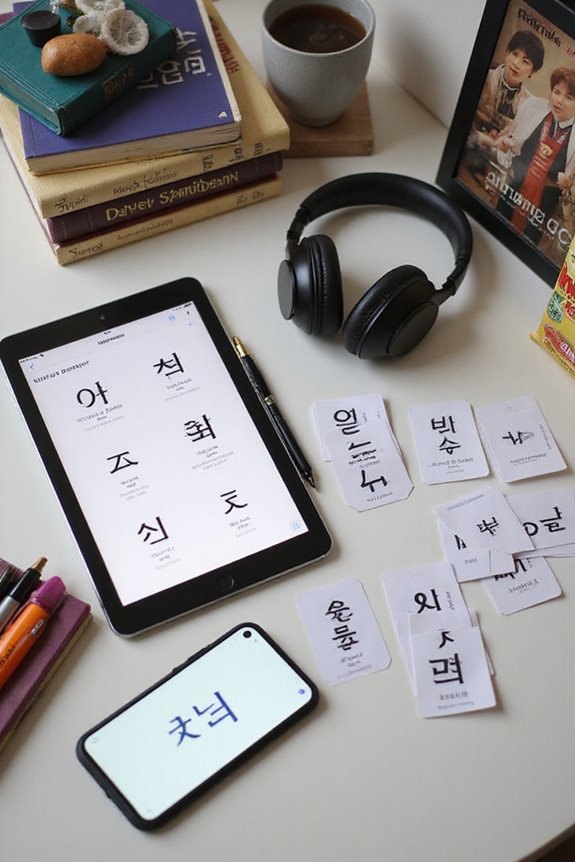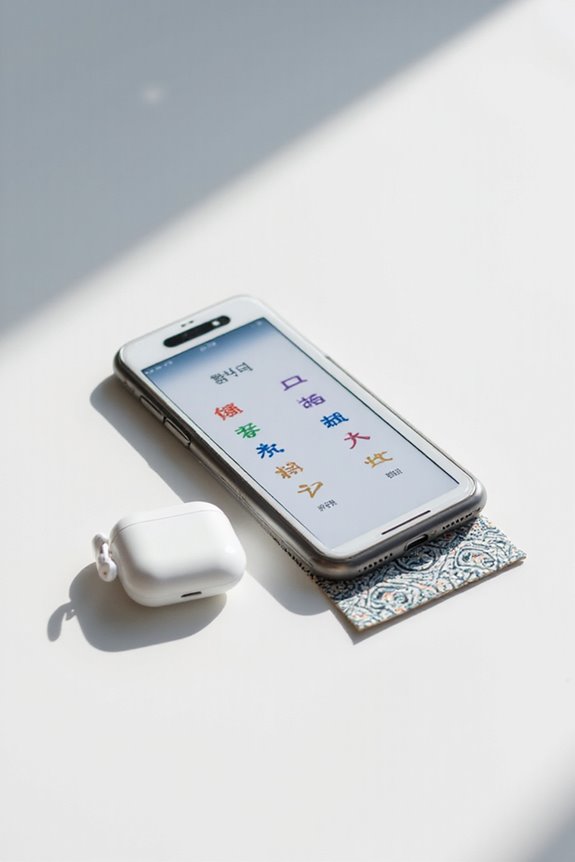For effective Korean language learning, we can utilize a variety of tools tailored to our needs. Beginners may find apps like LingoDeer and Duolingo useful for structured courses and vocabulary acquisition. As we progress, advanced resources such as Naver Dictionary and Papago offer in-depth understanding and translation assistance. Additionally, engaging with speaking and listening resources, like “Talk To Me In Korean” podcasts, can improve our proficiency. Exploring these options will further enhance our language journey.
Key Takeaways
- LingoDeer and Duolingo offer structured courses and gamified lessons respectively, ideal for beginners in Korean language learning.
- Naver Dictionary is essential for both vocabulary building and advanced searches, making it useful for all learner levels.
- Talk To Me In Korean provides community support and various resources, enhancing both learning and cultural understanding.
- KoreanClass101 and Pimsleur focus on auditory learning, improving pronunciation and listening skills for practical communication.
- Incorporating media like Korean dramas and podcasts enriches language immersion and comprehension through real-world contexts.
Popular Korean Language Learning Apps
As we explore the domain of Korean language learning apps, it’s important to recognize that our choices can greatly impact our language acquisition journey. Numerous popular apps each offer unique app features that cater to different learning styles. For instance, LingoDeer provides an extensive structure that integrates vocabulary and grammar, enhancing user experiences for those seeking a complete course. In contrast, Duolingo’s gamified approach appeals to many, though some find it less thorough than LingoDeer’s offerings. Additionally, Drops focuses specifically on vocabulary through visual illustrations, while Talk To Me In Korean presents a blend of lessons with community support. All these options allow us to select tools that align with our language goals, ultimately shaping our learning journey effectively.
Beginner-Friendly Tools for New Learners

Beginning the journey of learning the Korean language can feel overwhelming, yet there are numerous beginner-friendly tools available that simplify this process. Online dictionaries like Naver Dictionary and the Korean-English Learners Dictionary help us build our beginner vocabulary with essential words and phrases. Additionally, platforms such as KoreanClass101 support our basic pronunciation through audio lessons and contextual usage. Typing tools, including Google Korean Input and interactive games like “Hunger Attack,” enhance our skills in using Hangul effectively. Furthermore, web-based courses from sources like Langintro and Duolingo provide structured lessons to develop foundational knowledge. Finally, communities such as Reddit’s r/Korean offer valuable support for any questions we face along our learning path. Engaging with resources like Korean Short Stories for Beginners can also enhance our understanding of the language through enjoyable reading practice.
Advanced Tools for Proficient Learners

For proficient learners of the Korean language, utilizing advanced tools can greatly enhance our linguistic capabilities and deepen our understanding. One valuable resource is the Naver Dictionary, which offers sections for advanced vocabulary, including a Hanja dictionary and example sentences. We can also explore Papago, an app that provides reliable translations and can save our frequently searched words for quick access. Immersive experiences are crucial, and platforms like Viki allow us to watch Korean dramas with subtitles, enhancing our cultural context. Additionally, Speakly employs real-life communication practices, making it ideal for developing fluency. Finally, taking advantage of Accentia’s pronunciation features helps solidify our understanding of native pronunciation, further enriching our advanced learning journey. Moreover, integrating resources like Integrated Korean will provide a comprehensive approach to vocabulary and grammar acquisition.
Speaking and Listening Practice Resources

Effective speaking and listening practice resources are essential for mastering the Korean language, as they provide structured approaches to develop these key skills. Utilizing active listening techniques, such as dictation and shadowing, can enhance our comprehension and pronunciation improvement. Integrating passive listening methods, like background Korean dramas or podcasts, helps us acclimate to natural speech rhythms and nuances. Podcasts, such as “Talk To Me In Korean,” cater to various proficiency levels, offering vocabulary and cultural insights in an accessible format. Additionally, mobile apps that include speech-to-text features enable us to practice pronunciation while engaging in interactive dialogues. Together, these resources foster a thorough learning experience, allowing us to progress steadily towards fluency in Korean. Incorporating cultural elements in our practice sessions can also enrich our understanding of context and usage in real-life situations.
Reading and Writing Skills Development

After refining our speaking and listening skills, it’s important to focus on developing our reading and writing capabilities in Korean. Tools like “Let’s Learn Hangul” provide interactive lessons that help beginners grasp the Korean alphabet effectively. To enhance our handwriting, “Draw Korean” gives real-time feedback on forming Hangul characters, promoting the mastery of handwriting techniques. Meanwhile, “Beelinguapp” supports reading comprehension through side-by-side translations and audio narration, making texts accessible while we improve. Additionally, structured courses like “90 Day Korean” offer step-by-step guides to accelerate reading and writing progress. By utilizing these resources, we can strengthen our grasp of both reading and writing, laying a solid foundation for more advanced language skills. Furthermore, incorporating interactive elements from various courses can significantly enhance our overall learning experience.
Tools for Specialized Learning Needs
As we seek to meet our unique learning needs in Korean language acquisition, various tools are available to accommodate different styles and preferences. For auditory learners, programs like Pimsleur and KoreanClass101 offer effective auditory learning tools through interactive audio lessons and podcast-style content that enhances listening skills. Additionally, platforms such as Rocket Languages and Speechling provide extensive audio materials, focusing on conversational fluency and feedback from native speakers. For those who prefer interactive lesson platforms, Teuida and Talk To Me In Korean foster speaking practice, while Beelinguapp combines reading and listening features to enhance comprehension. These resources guarantee we can personalize our learning path, catering to our specific needs and preferences in mastering the Korean language.
Language Exchange Platforms for Practice
Language exchange platforms play an essential role in enhancing our Korean language practice by connecting us with native speakers and fellow learners. Apps like HelloTalk and Tandem facilitate effective partner matching, allowing us to practice through text, voice, and video. Hilokal takes this further with AI-driven chat rooms and themed discussions, promoting language immersion. We can enhance our learning experience by engaging in interactive activities and community events, which foster deeper connections. For those seeking long-term partnerships, platforms such as MyLanguageExchange offer detailed profiles to guarantee compatible connections. These consistent exchanges not only improve our speaking and writing skills but also provide cultural insights, increasing our overall understanding and appreciation of the Korean language. Additionally, utilizing resources like supplementary materials can further enrich our language learning journey and provide diverse methods of practice.
Frequently Asked Questions
Are There Any Age Restrictions for Using Korean Language Learning Apps?
While we all journey through different ages, there aren’t strict age requirements for Korean language learning apps. User safety is prioritized, ensuring everyone finds their rhythm in learning, no matter their stage in life.
How Do I Choose the Best App for My Learning Style?
To choose the best app for our learning style, we should consider our personal preferences and the app features that align with them, like grammar focus, speaking practice, or immersive content for effective learning.
Can I Use Multiple Tools Simultaneously for Better Learning?
Imagine juggling different colored balls; using multiple tools simultaneously creates a vibrant learning experience. Tool compatibility enhances our skills, making it easier to practice diverse aspects and solidify our grasp of the language together.
Are There Offline Options for Learning Korean With These Tools?
Absolutely, we’ve got great offline resources for learning Korean! Apps like iSpeak and Learn Korean Offline complement our language books, offering interactive lessons and quizzes that make studying on the go both effective and enjoyable.
How Can I Track My Progress While Learning Korean?
When we set monthly learning milestones, like mastering 50 vocabulary words, we can track our progress effectively using notebooks and online quizzes. This approach really motivates us to stay committed and celebrate our achievements.





